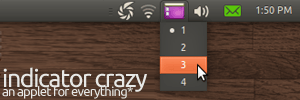
Some time back the Ayatana project introduced the [Application Indicator Framework](https://wiki.ubuntu.com/DesktopExperienceTeam/ApplicationIndicators), based upon technology created by the KDE project. We have been shipping this technology in Ubuntu for a few releases now and it makes the *top-right* part of the desktop a smooth, efficient, and pleasant experience, getting over the inconsistent and limiting notification area we had before.
To help build integration in the GNOME panel for this indicator work we had Ted Gould, Cody Somerville, and Jason Smith produce an implementation complete with C, Python and C# bindings, had Aurélien Gâteau continue to perform his excellent work with KDE, and Jorge Castro to help spread awareness of this work. In addition to this we contracted some developers to port apps with notification indicators that we ship in Ubuntu to the new framework, and this included apps such as Brasero, GNOME Bluetooth, GNOME Power Manager, Gnome Settings Daemon, XChat-GNOME, iBus, Nautilus, Policykit GNOME, Empathy, Gwibber and more. All of these patches are publicly available if other distros would like to use them.
The community has really got involved with the technology too, with community patches for Lernid, Banshee, LottaNZB, and DejaDup, and [System Monitor](https://www.omgubuntu.co.uk/2010/08/indicator-monitor-puts-system-stressing.html), [Weather](https://www.omgubuntu.co.uk/2010/06/weather-indicator-applet-genesis-of.html), [Screenshotting](https://www.omgubuntu.co.uk/2010/08/lookout-indicator-screenshotting-tool.html), [Workspaces](https://www.omgubuntu.co.uk/2010/08/indicator-workspaces-does-what-it-says.html), [Device Mounting](https://www.omgubuntu.co.uk/2010/08/safety-remove-usb-drives-using-nifty.html) indicators, support for the indicator framework built into AWN and Lubuntu, and more. I am absolutely delighted to see so much interest from application developers in the technology.








